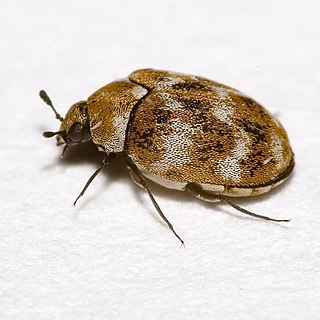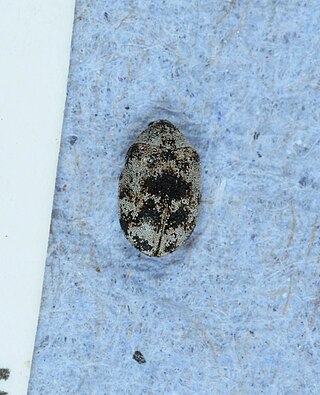
Anthrenus is a genus of beetles in the family Dermestidae, the skin beetles. One of several genera of carpet beetles, Anthrenus was historically placed in a subfamily Anthreninae, though presently included in the Megatominae. The genus Neoanthrenus is closely related.

Anthrenini is a tribe of beetles in the family Dermestidae. There are at least 100 described species in Anthrenini.

Anthrenus lepidus is a species of carpet beetle in the family Dermestidae. It is found in North America.

Anthrenus sophonisba is a species of carpet beetle in the family Dermestidae. It is known from United States.

Anthrenus festivus is a species of carpet beetle in the family Dermestidae. It is generally found in Western Europe: Austria, France, Germany, Portugal, Italy, Spain, Switzerland. Species also appears in Northern Africa, Israel and possibly in Cyprus.

Anthrenodes is a subgenus of the genus Anthrenus of the subfamily Megatominae within the family of skin beetles. Subgenus is distinguished by antennae with 10 segments.

Anthrenops is a subgenus of the genus Anthrenus of the subfamily Megatominae within the family of skin beetles. Subgenus is distinguished by antennae with 9 segments.
Ranthenus is a subgenus of the genus Anthrenus of the subfamily Megatominae within the family of skin beetles. Species of subgenus are present only in Asia and Turkey. Subgenus is distinguished by antennae with 4 segments.

Helocerus is a subgenus of the genus Anthrenus of the subfamily Megatominae within the family of skin beetles. Subgenus is distinguished by antennae with 5 segments.

Solskinus is a subgenus of the genus Anthrenus of the subfamily Megatominae within the family of skin beetles. Subgenus is distinguished by antennae with 7 segments.

Florilinus is a subgenus of the genus Anthrenus of the subfamily Megatominae within the family of skin beetles. Subgenus is distinguished by antennae with 8 segments.

Nathrenus is a subgenus of the genus Anthrenus of the subfamily Megatominae within the family of skin beetles. The most well-known species from the subgenus, varied carpet beetle, is distributed in most parts of the world, whereas the vast majority of other species are only present in regions of Africa and Asia.

Anthrenus is a subgenus of the genus Anthrenus of the subfamily Megatominae within the family of skin beetles.
Anthrenus bilyi is a species of carpet beetle in the family Dermestidae. The species is known from Central Asia and Armenia. It has close resemblance to common species, Anthrenus scrophulariae.

Anthrenus picturatus is a species of carpet beetle in the family Dermestidae. The species is usually known from regions of Russia, Eastern Europe and Asia.

Anthrenus omoi is a species of carpet beetle in the subgenus Anthrenodes of the genus Anthrenus, family Dermestidae. It is known from Mexico (Sonora) and the United States (Arizona).

Anthrenus chiton is a species of carpet beetle in the subgenus Anthrenus of the genus Anthrenus, family Dermestidae. It is known from the United States.

Anthrenus umbra is a species of carpet beetle in the subgenus Anthrenus of the genus Anthrenus, family Dermestidae. It is known from Mexico (Sonora) and the United States (Arizona).

Anthrenus pimpinellae complex is a group of closely related species from subgenus Anthrenus. Most species that currently belong to the group were previously assigned as subspecies of Anthrenus pimpinellae.
Anthrenus miniopictus is a species of carpet beetle in the family Dermestidae. It is known from Spain, Algeria, Morocco, and Tunisia.


















